Analysis of Cyber Operations, Information Warfare, and Decision Making
VerifiedAdded on 2022/09/12
|7
|1493
|11
Report
AI Summary
This report provides an overview of cyber operations, focusing on the key areas of information warfare, the information environment, and decision-making processes. It begins by defining information warfare and its role in conflict, followed by an analysis of the 'fog of cyber war' and the complexities of cyberspace. The report then examines the information environment, highlighting the challenges and changes within it, as well as the impact on military operations. The report also discusses the importance of managing cyber risk and the challenges of decision-making in the context of cyber threats, including the difficulty in measuring the benefits and costs of investments in information security. The report concludes by emphasizing the need for careful consideration of missions within cyberspace and the use of formal methods to ensure specific properties of the environment. References are included to support the analysis.
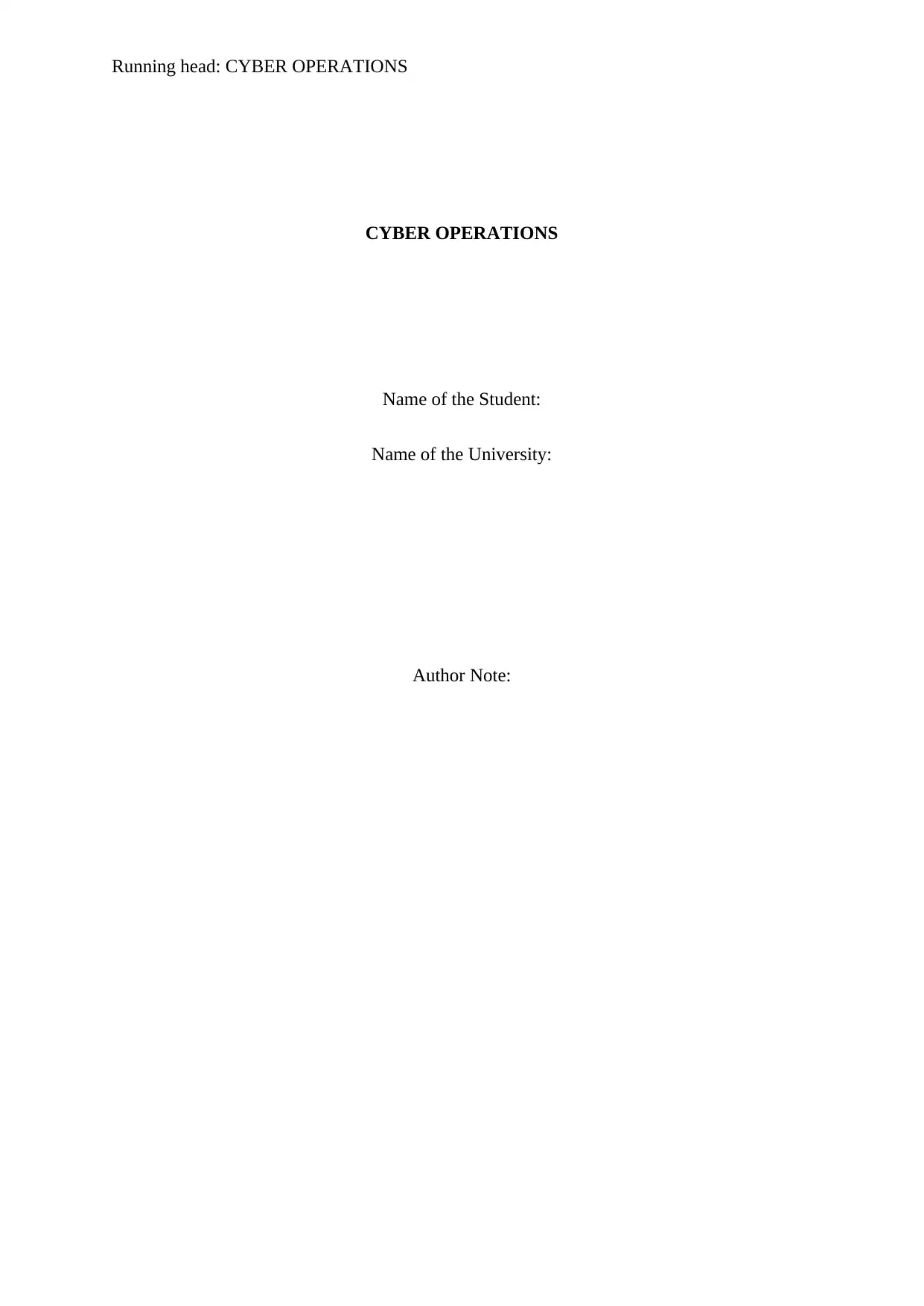
Running head: CYBER OPERATIONS
CYBER OPERATIONS
Name of the Student:
Name of the University:
Author Note:
CYBER OPERATIONS
Name of the Student:
Name of the University:
Author Note:
Paraphrase This Document
Need a fresh take? Get an instant paraphrase of this document with our AI Paraphraser
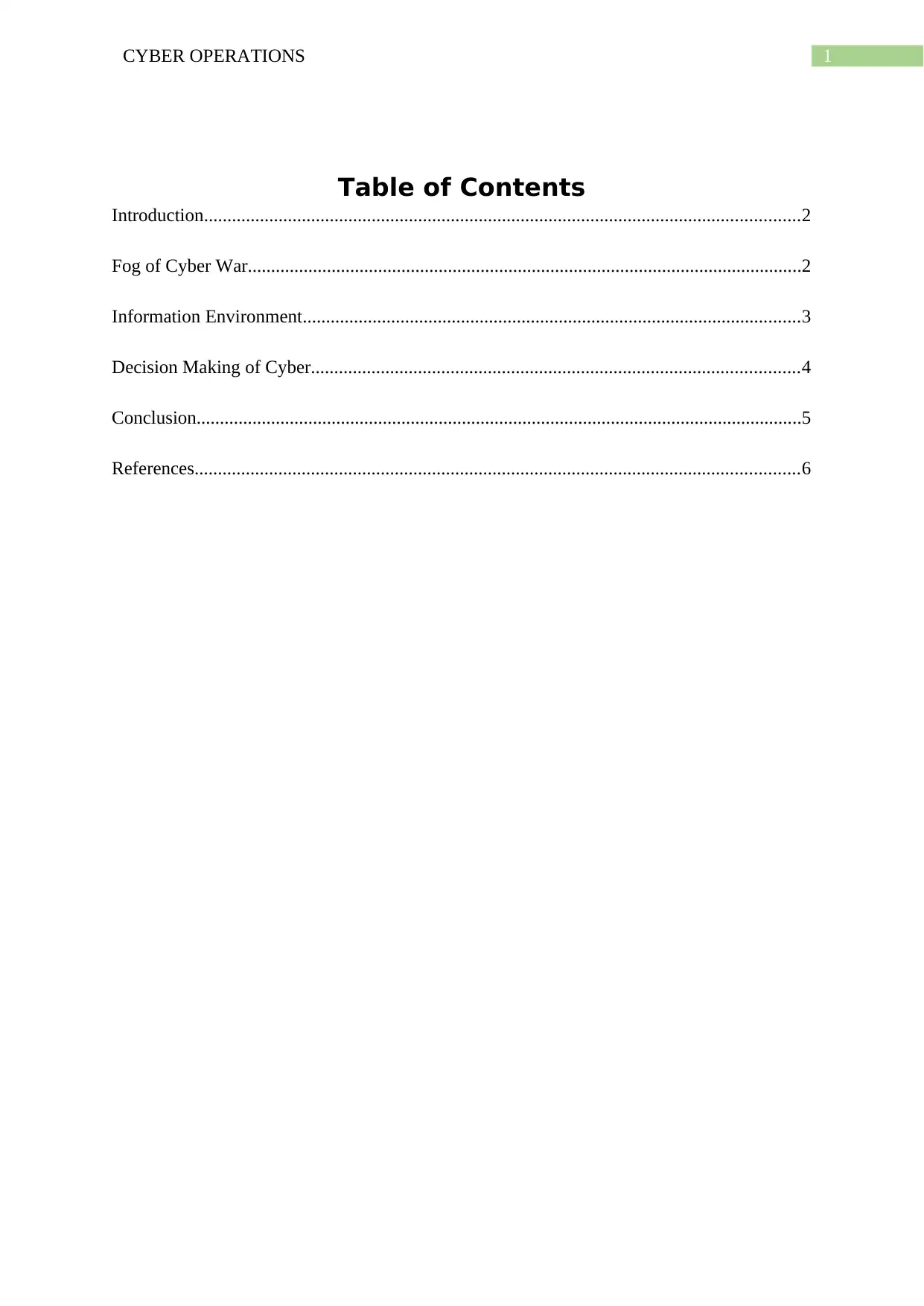
1CYBER OPERATIONS
Table of Contents
Introduction................................................................................................................................2
Fog of Cyber War.......................................................................................................................2
Information Environment...........................................................................................................3
Decision Making of Cyber.........................................................................................................4
Conclusion..................................................................................................................................5
References..................................................................................................................................6
Table of Contents
Introduction................................................................................................................................2
Fog of Cyber War.......................................................................................................................2
Information Environment...........................................................................................................3
Decision Making of Cyber.........................................................................................................4
Conclusion..................................................................................................................................5
References..................................................................................................................................6
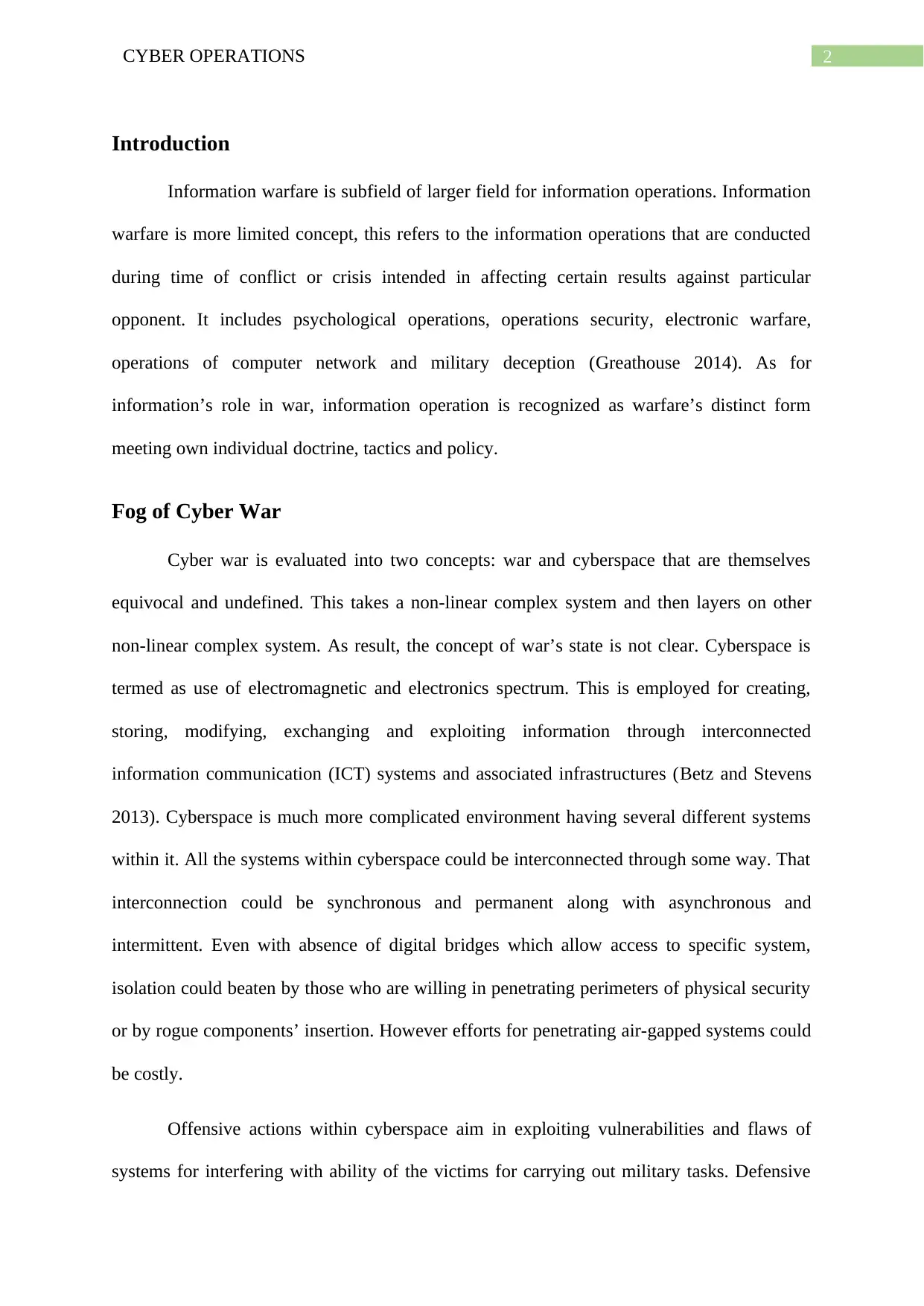
2CYBER OPERATIONS
Introduction
Information warfare is subfield of larger field for information operations. Information
warfare is more limited concept, this refers to the information operations that are conducted
during time of conflict or crisis intended in affecting certain results against particular
opponent. It includes psychological operations, operations security, electronic warfare,
operations of computer network and military deception (Greathouse 2014). As for
information’s role in war, information operation is recognized as warfare’s distinct form
meeting own individual doctrine, tactics and policy.
Fog of Cyber War
Cyber war is evaluated into two concepts: war and cyberspace that are themselves
equivocal and undefined. This takes a non-linear complex system and then layers on other
non-linear complex system. As result, the concept of war’s state is not clear. Cyberspace is
termed as use of electromagnetic and electronics spectrum. This is employed for creating,
storing, modifying, exchanging and exploiting information through interconnected
information communication (ICT) systems and associated infrastructures (Betz and Stevens
2013). Cyberspace is much more complicated environment having several different systems
within it. All the systems within cyberspace could be interconnected through some way. That
interconnection could be synchronous and permanent along with asynchronous and
intermittent. Even with absence of digital bridges which allow access to specific system,
isolation could beaten by those who are willing in penetrating perimeters of physical security
or by rogue components’ insertion. However efforts for penetrating air-gapped systems could
be costly.
Offensive actions within cyberspace aim in exploiting vulnerabilities and flaws of
systems for interfering with ability of the victims for carrying out military tasks. Defensive
Introduction
Information warfare is subfield of larger field for information operations. Information
warfare is more limited concept, this refers to the information operations that are conducted
during time of conflict or crisis intended in affecting certain results against particular
opponent. It includes psychological operations, operations security, electronic warfare,
operations of computer network and military deception (Greathouse 2014). As for
information’s role in war, information operation is recognized as warfare’s distinct form
meeting own individual doctrine, tactics and policy.
Fog of Cyber War
Cyber war is evaluated into two concepts: war and cyberspace that are themselves
equivocal and undefined. This takes a non-linear complex system and then layers on other
non-linear complex system. As result, the concept of war’s state is not clear. Cyberspace is
termed as use of electromagnetic and electronics spectrum. This is employed for creating,
storing, modifying, exchanging and exploiting information through interconnected
information communication (ICT) systems and associated infrastructures (Betz and Stevens
2013). Cyberspace is much more complicated environment having several different systems
within it. All the systems within cyberspace could be interconnected through some way. That
interconnection could be synchronous and permanent along with asynchronous and
intermittent. Even with absence of digital bridges which allow access to specific system,
isolation could beaten by those who are willing in penetrating perimeters of physical security
or by rogue components’ insertion. However efforts for penetrating air-gapped systems could
be costly.
Offensive actions within cyberspace aim in exploiting vulnerabilities and flaws of
systems for interfering with ability of the victims for carrying out military tasks. Defensive
⊘ This is a preview!⊘
Do you want full access?
Subscribe today to unlock all pages.

Trusted by 1+ million students worldwide
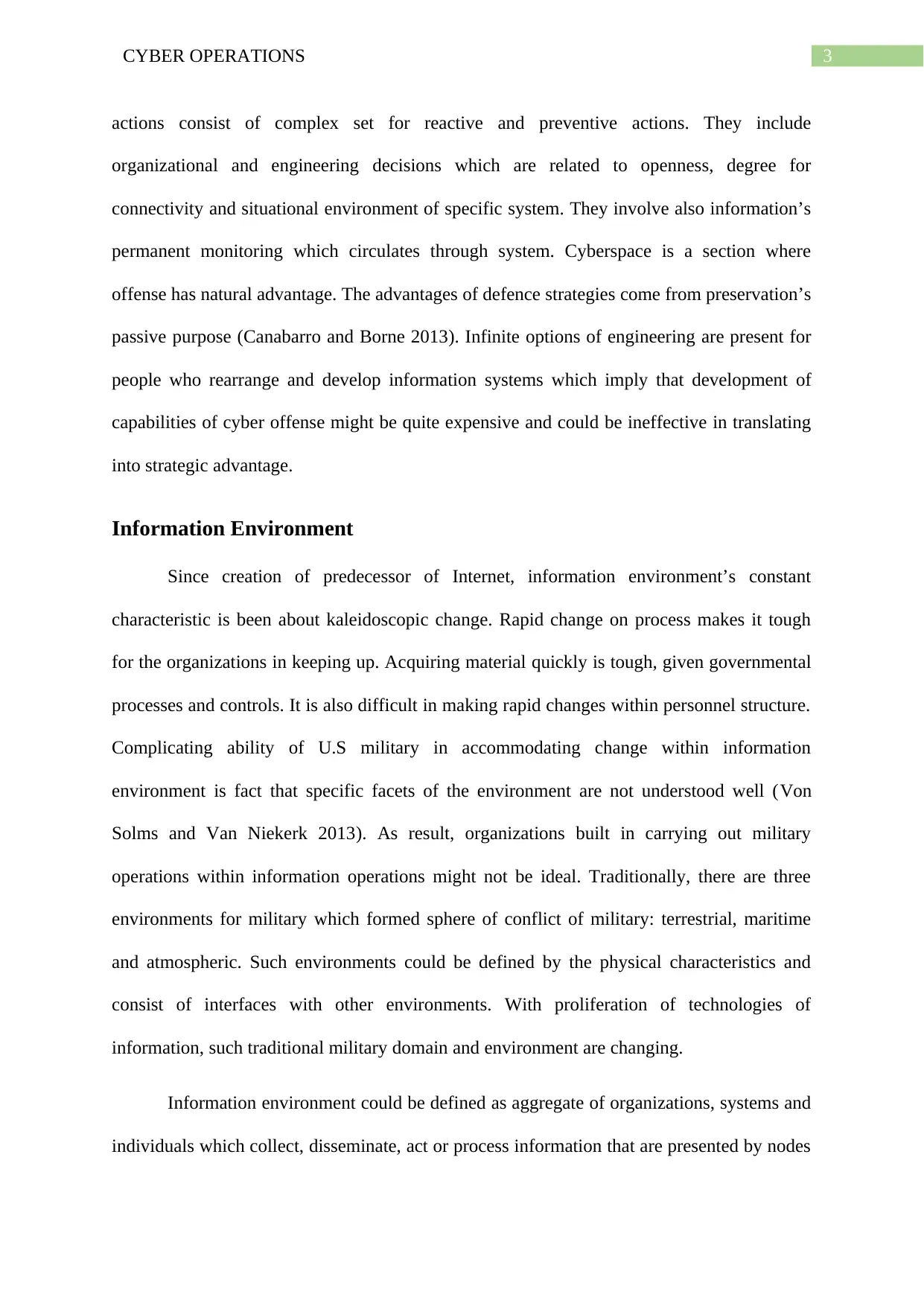
3CYBER OPERATIONS
actions consist of complex set for reactive and preventive actions. They include
organizational and engineering decisions which are related to openness, degree for
connectivity and situational environment of specific system. They involve also information’s
permanent monitoring which circulates through system. Cyberspace is a section where
offense has natural advantage. The advantages of defence strategies come from preservation’s
passive purpose (Canabarro and Borne 2013). Infinite options of engineering are present for
people who rearrange and develop information systems which imply that development of
capabilities of cyber offense might be quite expensive and could be ineffective in translating
into strategic advantage.
Information Environment
Since creation of predecessor of Internet, information environment’s constant
characteristic is been about kaleidoscopic change. Rapid change on process makes it tough
for the organizations in keeping up. Acquiring material quickly is tough, given governmental
processes and controls. It is also difficult in making rapid changes within personnel structure.
Complicating ability of U.S military in accommodating change within information
environment is fact that specific facets of the environment are not understood well (Von
Solms and Van Niekerk 2013). As result, organizations built in carrying out military
operations within information operations might not be ideal. Traditionally, there are three
environments for military which formed sphere of conflict of military: terrestrial, maritime
and atmospheric. Such environments could be defined by the physical characteristics and
consist of interfaces with other environments. With proliferation of technologies of
information, such traditional military domain and environment are changing.
Information environment could be defined as aggregate of organizations, systems and
individuals which collect, disseminate, act or process information that are presented by nodes
actions consist of complex set for reactive and preventive actions. They include
organizational and engineering decisions which are related to openness, degree for
connectivity and situational environment of specific system. They involve also information’s
permanent monitoring which circulates through system. Cyberspace is a section where
offense has natural advantage. The advantages of defence strategies come from preservation’s
passive purpose (Canabarro and Borne 2013). Infinite options of engineering are present for
people who rearrange and develop information systems which imply that development of
capabilities of cyber offense might be quite expensive and could be ineffective in translating
into strategic advantage.
Information Environment
Since creation of predecessor of Internet, information environment’s constant
characteristic is been about kaleidoscopic change. Rapid change on process makes it tough
for the organizations in keeping up. Acquiring material quickly is tough, given governmental
processes and controls. It is also difficult in making rapid changes within personnel structure.
Complicating ability of U.S military in accommodating change within information
environment is fact that specific facets of the environment are not understood well (Von
Solms and Van Niekerk 2013). As result, organizations built in carrying out military
operations within information operations might not be ideal. Traditionally, there are three
environments for military which formed sphere of conflict of military: terrestrial, maritime
and atmospheric. Such environments could be defined by the physical characteristics and
consist of interfaces with other environments. With proliferation of technologies of
information, such traditional military domain and environment are changing.
Information environment could be defined as aggregate of organizations, systems and
individuals which collect, disseminate, act or process information that are presented by nodes
Paraphrase This Document
Need a fresh take? Get an instant paraphrase of this document with our AI Paraphraser
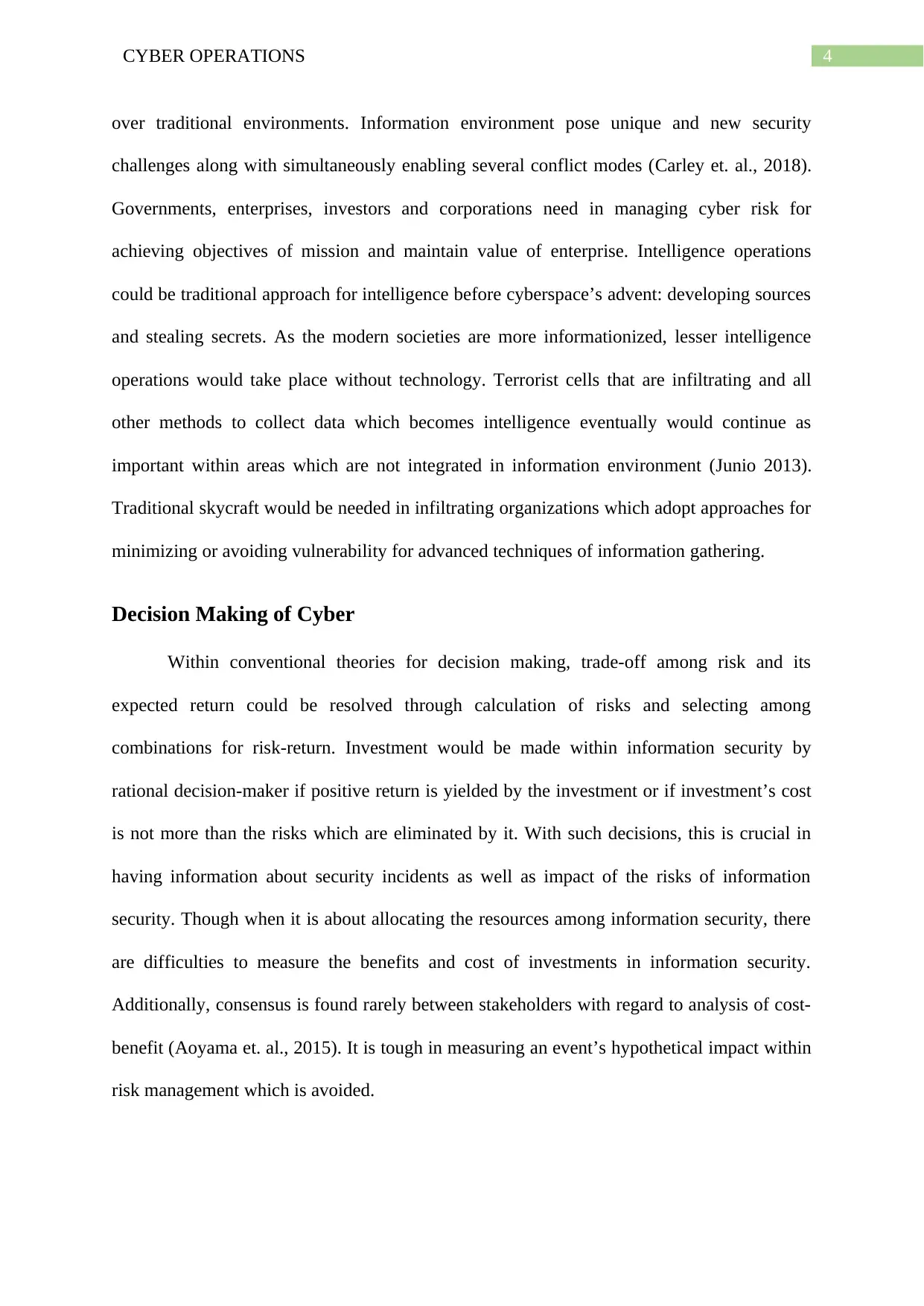
4CYBER OPERATIONS
over traditional environments. Information environment pose unique and new security
challenges along with simultaneously enabling several conflict modes (Carley et. al., 2018).
Governments, enterprises, investors and corporations need in managing cyber risk for
achieving objectives of mission and maintain value of enterprise. Intelligence operations
could be traditional approach for intelligence before cyberspace’s advent: developing sources
and stealing secrets. As the modern societies are more informationized, lesser intelligence
operations would take place without technology. Terrorist cells that are infiltrating and all
other methods to collect data which becomes intelligence eventually would continue as
important within areas which are not integrated in information environment (Junio 2013).
Traditional skycraft would be needed in infiltrating organizations which adopt approaches for
minimizing or avoiding vulnerability for advanced techniques of information gathering.
Decision Making of Cyber
Within conventional theories for decision making, trade-off among risk and its
expected return could be resolved through calculation of risks and selecting among
combinations for risk-return. Investment would be made within information security by
rational decision-maker if positive return is yielded by the investment or if investment’s cost
is not more than the risks which are eliminated by it. With such decisions, this is crucial in
having information about security incidents as well as impact of the risks of information
security. Though when it is about allocating the resources among information security, there
are difficulties to measure the benefits and cost of investments in information security.
Additionally, consensus is found rarely between stakeholders with regard to analysis of cost-
benefit (Aoyama et. al., 2015). It is tough in measuring an event’s hypothetical impact within
risk management which is avoided.
over traditional environments. Information environment pose unique and new security
challenges along with simultaneously enabling several conflict modes (Carley et. al., 2018).
Governments, enterprises, investors and corporations need in managing cyber risk for
achieving objectives of mission and maintain value of enterprise. Intelligence operations
could be traditional approach for intelligence before cyberspace’s advent: developing sources
and stealing secrets. As the modern societies are more informationized, lesser intelligence
operations would take place without technology. Terrorist cells that are infiltrating and all
other methods to collect data which becomes intelligence eventually would continue as
important within areas which are not integrated in information environment (Junio 2013).
Traditional skycraft would be needed in infiltrating organizations which adopt approaches for
minimizing or avoiding vulnerability for advanced techniques of information gathering.
Decision Making of Cyber
Within conventional theories for decision making, trade-off among risk and its
expected return could be resolved through calculation of risks and selecting among
combinations for risk-return. Investment would be made within information security by
rational decision-maker if positive return is yielded by the investment or if investment’s cost
is not more than the risks which are eliminated by it. With such decisions, this is crucial in
having information about security incidents as well as impact of the risks of information
security. Though when it is about allocating the resources among information security, there
are difficulties to measure the benefits and cost of investments in information security.
Additionally, consensus is found rarely between stakeholders with regard to analysis of cost-
benefit (Aoyama et. al., 2015). It is tough in measuring an event’s hypothetical impact within
risk management which is avoided.
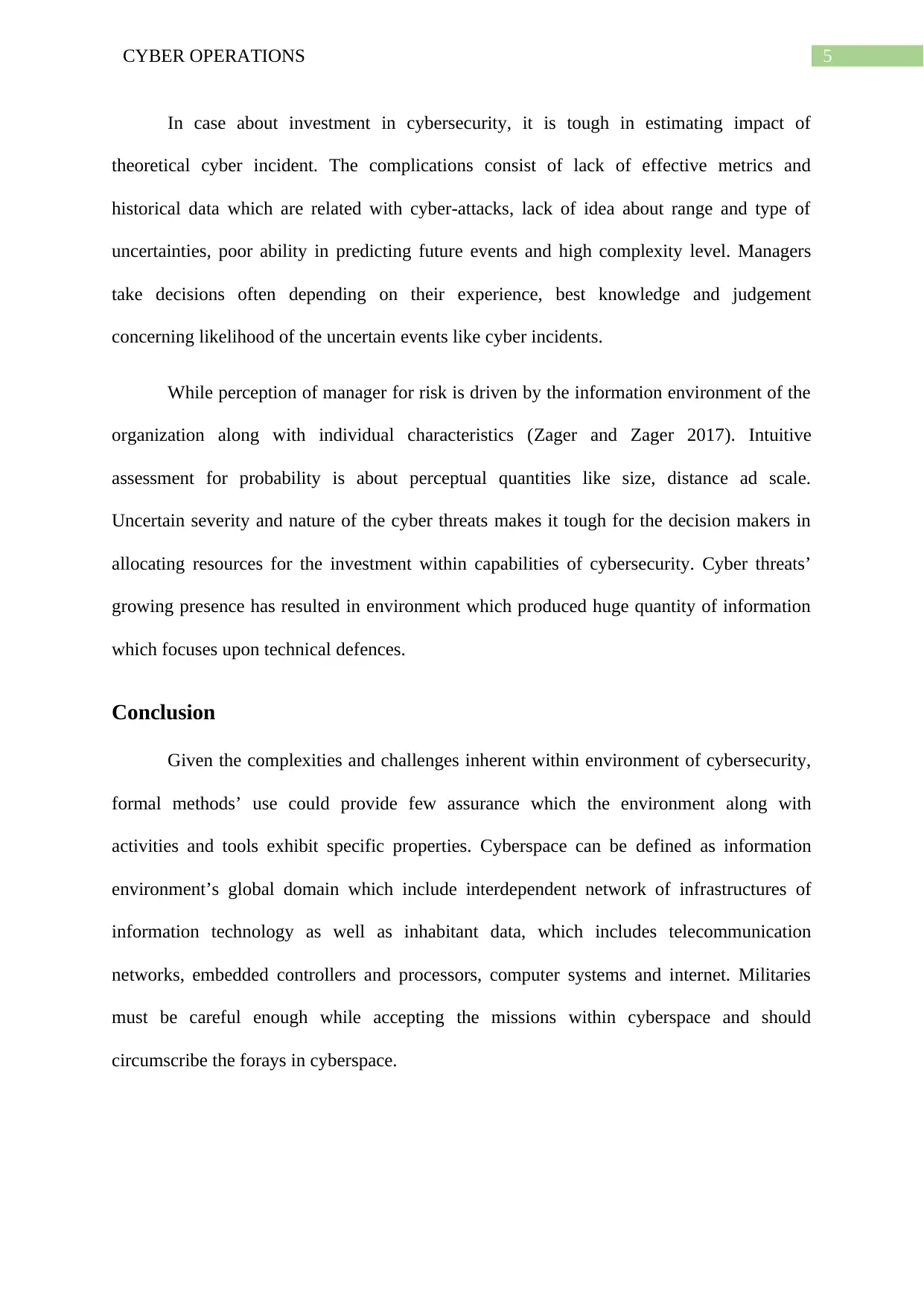
5CYBER OPERATIONS
In case about investment in cybersecurity, it is tough in estimating impact of
theoretical cyber incident. The complications consist of lack of effective metrics and
historical data which are related with cyber-attacks, lack of idea about range and type of
uncertainties, poor ability in predicting future events and high complexity level. Managers
take decisions often depending on their experience, best knowledge and judgement
concerning likelihood of the uncertain events like cyber incidents.
While perception of manager for risk is driven by the information environment of the
organization along with individual characteristics (Zager and Zager 2017). Intuitive
assessment for probability is about perceptual quantities like size, distance ad scale.
Uncertain severity and nature of the cyber threats makes it tough for the decision makers in
allocating resources for the investment within capabilities of cybersecurity. Cyber threats’
growing presence has resulted in environment which produced huge quantity of information
which focuses upon technical defences.
Conclusion
Given the complexities and challenges inherent within environment of cybersecurity,
formal methods’ use could provide few assurance which the environment along with
activities and tools exhibit specific properties. Cyberspace can be defined as information
environment’s global domain which include interdependent network of infrastructures of
information technology as well as inhabitant data, which includes telecommunication
networks, embedded controllers and processors, computer systems and internet. Militaries
must be careful enough while accepting the missions within cyberspace and should
circumscribe the forays in cyberspace.
In case about investment in cybersecurity, it is tough in estimating impact of
theoretical cyber incident. The complications consist of lack of effective metrics and
historical data which are related with cyber-attacks, lack of idea about range and type of
uncertainties, poor ability in predicting future events and high complexity level. Managers
take decisions often depending on their experience, best knowledge and judgement
concerning likelihood of the uncertain events like cyber incidents.
While perception of manager for risk is driven by the information environment of the
organization along with individual characteristics (Zager and Zager 2017). Intuitive
assessment for probability is about perceptual quantities like size, distance ad scale.
Uncertain severity and nature of the cyber threats makes it tough for the decision makers in
allocating resources for the investment within capabilities of cybersecurity. Cyber threats’
growing presence has resulted in environment which produced huge quantity of information
which focuses upon technical defences.
Conclusion
Given the complexities and challenges inherent within environment of cybersecurity,
formal methods’ use could provide few assurance which the environment along with
activities and tools exhibit specific properties. Cyberspace can be defined as information
environment’s global domain which include interdependent network of infrastructures of
information technology as well as inhabitant data, which includes telecommunication
networks, embedded controllers and processors, computer systems and internet. Militaries
must be careful enough while accepting the missions within cyberspace and should
circumscribe the forays in cyberspace.
⊘ This is a preview!⊘
Do you want full access?
Subscribe today to unlock all pages.

Trusted by 1+ million students worldwide
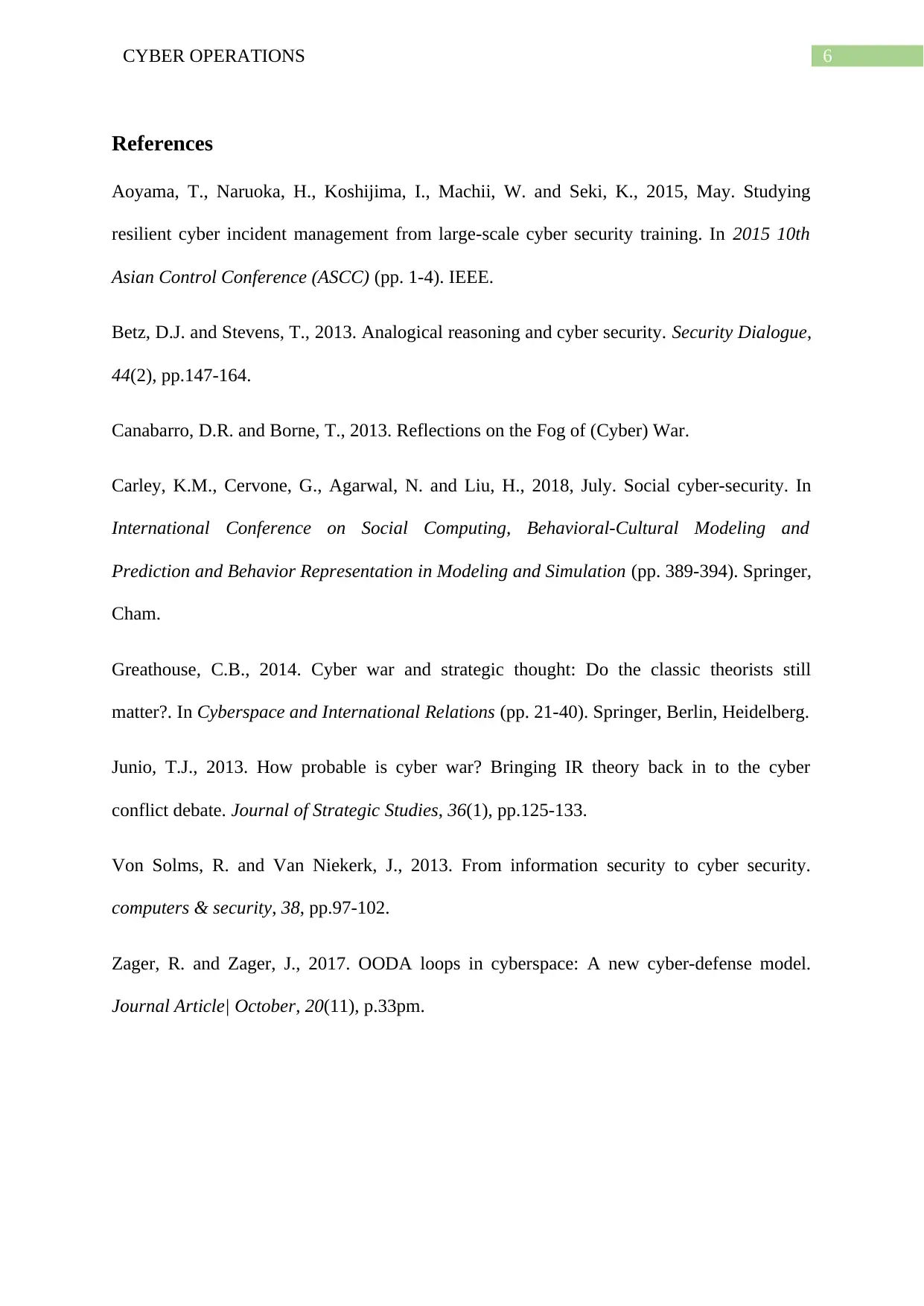
6CYBER OPERATIONS
References
Aoyama, T., Naruoka, H., Koshijima, I., Machii, W. and Seki, K., 2015, May. Studying
resilient cyber incident management from large-scale cyber security training. In 2015 10th
Asian Control Conference (ASCC) (pp. 1-4). IEEE.
Betz, D.J. and Stevens, T., 2013. Analogical reasoning and cyber security. Security Dialogue,
44(2), pp.147-164.
Canabarro, D.R. and Borne, T., 2013. Reflections on the Fog of (Cyber) War.
Carley, K.M., Cervone, G., Agarwal, N. and Liu, H., 2018, July. Social cyber-security. In
International Conference on Social Computing, Behavioral-Cultural Modeling and
Prediction and Behavior Representation in Modeling and Simulation (pp. 389-394). Springer,
Cham.
Greathouse, C.B., 2014. Cyber war and strategic thought: Do the classic theorists still
matter?. In Cyberspace and International Relations (pp. 21-40). Springer, Berlin, Heidelberg.
Junio, T.J., 2013. How probable is cyber war? Bringing IR theory back in to the cyber
conflict debate. Journal of Strategic Studies, 36(1), pp.125-133.
Von Solms, R. and Van Niekerk, J., 2013. From information security to cyber security.
computers & security, 38, pp.97-102.
Zager, R. and Zager, J., 2017. OODA loops in cyberspace: A new cyber-defense model.
Journal Article| October, 20(11), p.33pm.
References
Aoyama, T., Naruoka, H., Koshijima, I., Machii, W. and Seki, K., 2015, May. Studying
resilient cyber incident management from large-scale cyber security training. In 2015 10th
Asian Control Conference (ASCC) (pp. 1-4). IEEE.
Betz, D.J. and Stevens, T., 2013. Analogical reasoning and cyber security. Security Dialogue,
44(2), pp.147-164.
Canabarro, D.R. and Borne, T., 2013. Reflections on the Fog of (Cyber) War.
Carley, K.M., Cervone, G., Agarwal, N. and Liu, H., 2018, July. Social cyber-security. In
International Conference on Social Computing, Behavioral-Cultural Modeling and
Prediction and Behavior Representation in Modeling and Simulation (pp. 389-394). Springer,
Cham.
Greathouse, C.B., 2014. Cyber war and strategic thought: Do the classic theorists still
matter?. In Cyberspace and International Relations (pp. 21-40). Springer, Berlin, Heidelberg.
Junio, T.J., 2013. How probable is cyber war? Bringing IR theory back in to the cyber
conflict debate. Journal of Strategic Studies, 36(1), pp.125-133.
Von Solms, R. and Van Niekerk, J., 2013. From information security to cyber security.
computers & security, 38, pp.97-102.
Zager, R. and Zager, J., 2017. OODA loops in cyberspace: A new cyber-defense model.
Journal Article| October, 20(11), p.33pm.
1 out of 7
Your All-in-One AI-Powered Toolkit for Academic Success.
+13062052269
info@desklib.com
Available 24*7 on WhatsApp / Email
![[object Object]](/_next/static/media/star-bottom.7253800d.svg)
Unlock your academic potential
Copyright © 2020–2025 A2Z Services. All Rights Reserved. Developed and managed by ZUCOL.

